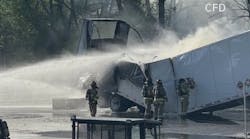Just about every fire apparatus carries ladders. Certainly, ladder companies have a whole assortment of various sizes, while engines often carry just a couple. Firefighters use ladders for a number of important operations and must be familiar with ladder terminology, uses and safety. Let’s take a look at portable ladders.
The first thing you must know is what size and how many portable ladders are carried on your apparatus. This may sound basic, but many firefighters cannot tell you exactly how many ladders are on their rig or even whether they have a specific-size ladder. Familiarize yourself with your apparatus and the tools and ladders it carries. If a 28-foot extension ladder is called for at the scene of a fire, you should know whether you have one and, if not, what size you have that’s closest to 28 feet.
Next, you need to know how far these ladders will reach. Make sure all of the ladders are properly marked with their lengths. If ladders are stored properly, the butt end will be facing the rear of the apparatus and that is where the length marking should be. Also be sure you know up to what height or to what floor each of the ladders can be positioned. When operating at a fire or emergency where a ladder is needed to get into a building or remove a trapped civilian, you don’t want to pull, transport and raise a ladder only to discover it is too short and won’t reach. You should know where a 20-foot straight ladder will reach. You should know what roofs in your response area can be accessed with a 28-foot extension ladder. You should know what size ladder to select to reach the second-floor window at a private dwelling. Know it!
Another basic yet vital piece of information you need is ladder positioning. Just where exactly does the tip of the ladder belong for specific situations? Here are a few basics:
1. At a window – The tip should be at or below the window sill. If you are going to climb in that window or remove a civilian from that window, you want to keep the ladder out of the window. Positioning the ladder below the sill makes for quick and easy entry and exit and for removal of victims.
2. To a flat roof – The tip of the ladder should be several feet above the point where the ladder is touching the building. Several feet means more than three. Try four or five feet above the roof. This positioning lets the firefighters climb all the way up until their feet are on a rung at roof level and they can simply step off the ladder onto the roof. Additionally, after dropping their tools onto the roof, the firefighters should still be holding the ladder securely with both hands.
3. To a peaked roof – The tip should be positioned the same way as the flat roof, several feet above the point of contact. If the peak is shallow and you can walk it, you are good. If the peak is steep and a roof ladder is needed, it should have its roof hooks opened before it is raised and handed up to the roof. Slide the roof ladder up to the peak on its beam and drop it into place after the hooks are pushed beyond the ridge. Try not to use a hook ladder that hangs past the bottom edge of the roof. If that section of ladder is mistakenly stepped on, it can dislodge the roof hooks and cause the ladder to fall.
Terminology is another important part of effective ladder work. Know what each ladder and each part of the ladder are named. We climb up and down on the rungs. We hold onto the ladder while climbing using the rails or beams. When we raise a ladder, we are changing its position from laying flat to standing up. When we extend a ladder, we are pulling the halyard until the ladder is at the desired height. The ladder is held at the selected height by the ladder locks, pawls or dogs. A ladder should be carried with the bottom or butt end leading so we can place the butt, base or foot of the ladder at the point that it is to be raised.
There are numerous safety issues related to the use of portable ladders. The first is proper carrying and raising skills. If you don’t know how to properly carry and raise a ladder, you are going to get hurt. There are shoulder carries, suitcase carries, and many other skills that you must know and practice.
A big issue when raising a portable ladder is that you must look up. Hitting a clothesline or tree branch halfway up could cause you to drop the ladder and be injured. If you hit an electrical wire, you could end up at a funeral – your own!
I’ll bet you didn’t know there was so much to know about portable ladders. We use them every day at many types of operations. Know what you are doing and practice doing it and you will look like the professional we all want to be.
JOHN J. SALKA Jr., a Firehouse® contributing editor, is a 28-year veteran battalion chief with FDNY, the commander of the 18th battalion in the Bronx. Salka has instructed at several FDNY training programs, including the department’s Probationary Firefighters School, Captains Management Program and Battalion Chiefs Command Course. He conducts training programs at national and local conferences and has been recognized for his firefighter survival course “Get Out Alive.” Salka co-authored the FDNY Engine Company Operations manual and wrote the book First In, Last Out – Leadership Lessons From the New York Fire Department. He also operates Fire Command Training (www.firecommandtraining.com), a New York-based fire service training and consulting firm.





